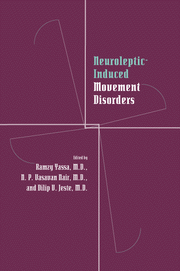Book contents
- Frontmatter
- Contents
- Contributors
- Preface
- Part I Historical perspective
- Part II Clinical aspects of tardive dyskinesia
- Part III Mechanisms underlying tardive dyskinesia
- Part IV Measurement of tardive dyskinesia
- Part V Tardive dyskinesia in different populations
- 19 Cultural aspects of tardive dyskinesia in Asia
- 20 Tardive dyskinesia in North America and the Middle East
- 21 Tardive dyskinesia in Europe
- 22 Role of ethnicity in the development of tardive dyskinesia
- 23 Tardive dyskinesia in children and adolescents
- Part VI Other neuroleptic-induced movement disorders
- Part VII Treatment of tardive dyskinesia
- Index
23 - Tardive dyskinesia in children and adolescents
from Part V - Tardive dyskinesia in different populations
Published online by Cambridge University Press: 09 October 2009
- Frontmatter
- Contents
- Contributors
- Preface
- Part I Historical perspective
- Part II Clinical aspects of tardive dyskinesia
- Part III Mechanisms underlying tardive dyskinesia
- Part IV Measurement of tardive dyskinesia
- Part V Tardive dyskinesia in different populations
- 19 Cultural aspects of tardive dyskinesia in Asia
- 20 Tardive dyskinesia in North America and the Middle East
- 21 Tardive dyskinesia in Europe
- 22 Role of ethnicity in the development of tardive dyskinesia
- 23 Tardive dyskinesia in children and adolescents
- Part VI Other neuroleptic-induced movement disorders
- Part VII Treatment of tardive dyskinesia
- Index
Summary
The prevalences of neuroleptic-induced tardive dyskinesia reported in studies of children and adolescents have matched or exceeded the prevalences reported in studies of adults (McAndrew, Case, & Treffert, 1972; Polizos et al., 1973; Engelhardt, Polizos, & Waizer, 1974; Paulson, Rizvi, & Crane, 1975; Polizos & Engelhardt, 1978; Frank & Djavadi, 1980; Jeste & Wyatt, 1981; Gualtieri et al., 1982, 1984, 1986; Kane et al., 1984; Campbell et al., 1988, 1990; Meiselas et al., 1989; Locascio et al., 1991). Those studies used a variety of disease definitions, research methods, and pediatric populations at risk for tardive dyskinesia. The comparative analysis of the literature presented in this chapter attempts to organize that heterogeneity and establish a range for the prevalence of tardive dyskinesia, as well as the more transient withdrawal dyskinesia.
Diagnosing tardive dyskinesia in children is a complicated matter. Highly variable neuroleptic exposures will have preceded the onset of tardive dyskinesia in children and adolescents (Campbell et al., 1983a). The symptoms of tardive dyskinesia will vary in frequency, severity, and anatomic distribution (Engelhardt et al., 1974; Simpson et al., 1979; Perry et al., 1985; Gualtieri et al., 1986). The use of maintenance neuroleptic treatment will make recognition of tardive dyskinesia more difficult by reducing its symptoms. At times, even indisputable cases of tardive dyskinesia may not be recognized clinically (Weidon et al., 1987), and patients may grossly underreport their symptoms (Alexopoulos, 1979).
- Type
- Chapter
- Information
- Neuroleptic-induced Movement DisordersA Comprehensive Survey, pp. 311 - 338Publisher: Cambridge University PressPrint publication year: 1996



